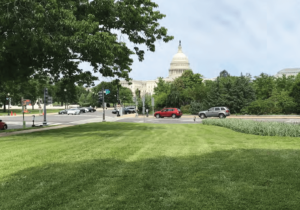The National Park Service (NPS), National Capital Planning Commission (NCPC), and Van Alen Institute has announced the winner of the Memorials for the Future ideas competition. Initiated in March this year, the competition has been a six-month process in which participants were encouraged to “reimagine the way we think about, feel, and experience memorials in Washington, D.C., and inspire new memorial approaches around the country.” The winning team: Climate Chronograph, comprised Bay Area-based landscape architects Erik Jensen and Rebecca Sunter. The winning pair imagined “a living observatory for the unfolding global story of climate change.”
Drawing submissions from more than 300 participants, Climate Chronograph triumphed after four finalists were chosen by a jury who looked for “innovative, distinct approaches.” In this last stage, finalists were urged to consider practicality, especially within real “technological limitations” and the “current requirements of the commemoration process.”
Conceived as an “evolving memorial for future conditions,” Climate Chronograph is situated in Hains Point, Washington, D.C. Here, the memorial can transform into a new ecosystem as its site—a grove of cherry trees—floods. The memorial is intended to be experienced over a lifetime. In this timeframe, visitors will witness “a legible demonstration of generation-paced change.” In doing so, the site memorializes the future and the effects of climate change that come with it. As a result, the memorial can be interpreted as a site that encourages visitors to combat climate change. Meanwhile, the memorial will still remain as a space for the activities such as fishing, picnics, and sports that take place there.
During the competition, the Van Alen Institute has documented some “key findings” they observed. The findings, in their words, present “ideas that best push forward our collective notions of memorialization.” They are:
- Engage The Present And Future As Much As The Past
- Allow For Changing Narratives
- Universal Experiences In Addition To Places, People And Events
- Use Local Settings For National Issues
- Create Memorials With The Public As Well As For The Public
- Consider Ephemeral, Mobile, And Temporary Forms
- Memorials Beyond Physical Space
- Challenges Our Future Memorials Face
This evening, Erik Jensen and Rebecca Sunter’s work will be on display in the Hall of Nations at the John F. Kennedy Center for the Performing Arts. Members of the four finalist teams will be present from 7:00pm to 8:00 p.m. The exhibition, which also showcases the three other finalists’ work, will be free and run through October 20, 2016. The teams will also present their proposals at the National Capital Planning Commission meeting at 1:00 p.m. today, which will be live-streamed at www.ncpc.gov/live.
“The National Park Service Centennial challenged us to think about new ways to engage the next generation and tell stories relevant to them. Memorials for the Future challenged us to think about how we will take the imagination displayed in this ideas competition and use it to spark a new generation of national park visitors, supporters and advocates, not to mention artists, architects and philosophers,” National Park Service Regional Director Bob Vogel said in a press release. “We’re committed to continuing this conversation and engaging people in the stories and commemorations that are important to them and to the shared heritage of our nation.”










